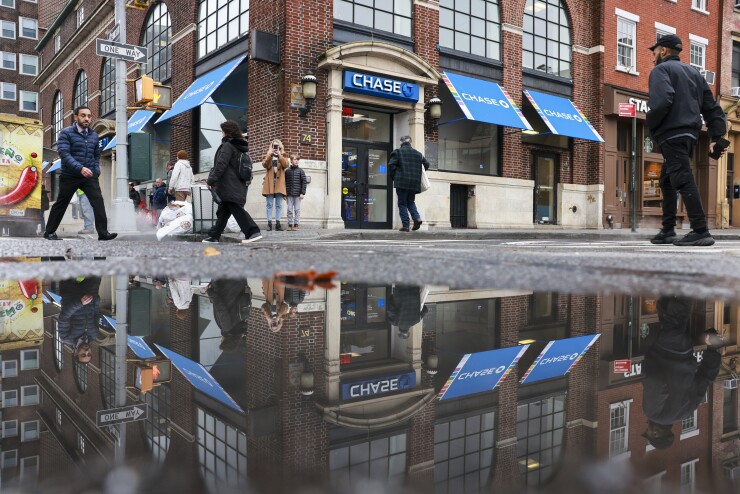The head of identity for consumer and community banking at JPMorgan Chase said last week that the bank is bringing more technology into its branches to ward off fraud and make life easier for tellers tasked with identifying it.
JPMorgan Chase is moving robust identity checks to the start of interactions inside branches by having each customer prove their identity at kiosks that ask for their account password or identification documents, rather than having a teller check the customer's driver's license by hand. That's according to Stefan Schubert, the bank's head of identity for consumer and community banking, who spoke last week at
The change is part of the bank's overall strategy of
The bank has invested in the branch network, Schubert said, because branches act as marketplaces for the various services JPMorgan Chase offers — auto loans, mortgages, business accounts and others — and it's seen direct benefits across lines of business connected to the expanding branch network.
"By having a branch anchored in a community, we're able to bolster all those services for ourselves, but there's also a much higher customer experience benefit of both being able to visit a branch and just know that there's one nearby," Schubert said.
But, in recent years, branches have become increasingly popular targets for fraudsters through a variety of means. For example, a trend that took hold among fraud rings last year was recruiting
In these schemes, fraudsters hoping to cash out on a fraudulent check need to find someone who matches the description of the payee on a fraudulent check. The payee might be a
Once the fraudster finds a recruit who can pass as the payee, they arm the recruit with the fraudulent check and, in some cases, a fraudulent form of identity. The recruit then walks into the branch to deposit or cash the check, and if they succeed, the fraudster shares some of the loot with them.
Check walking exploits the fallibility of tellers who are tasked with identifying whether the person on the other side of the counter is the actual payee and whether the check they are handing over is legitimate. Rather than relying on an automated process to vet the check, banks often rely on tellers to identify suspicious behavior.
JPMorgan Chase is hoping to change that by ensuring fraudsters don't pick on tellers as a weak link in the fraud prevention process. Instead, any fraudster hoping to walk into a branch and commit fraud will be faced with the same automated protections that exist online and in the bank's mobile app — the automated protections that the fraudster was hoping to avoid.
The main way JPMorgan Chase is doing this today is by installing kiosks inside branches where customers authenticate before visiting with an associate. In the branches where JPMorgan Chase has placed the kiosks so far, the units resemble ATMs but are designed specifically to verify the identity of the customer.
Customers entering JPMorgan Chase branches equipped with this identity verification technology are asked to authenticate at the kiosk first before receiving services from a teller. As the bank renovates branches, it plans to add similar identity verification technology.
Prior to the wave of digital transformation at banks, fraud prevention relied on the gut instincts of tellers. That's according to Kerry Cantley, who joined identity and fraud prevention firm Mitek last year after a 26-year career with Bank of America. Mitek sponsored the roundtable discussion on raising trust and convenience inside branches using digital identity technology.
What digital transformation has not changed, Cantley said, is banking customers'
"They like seeing the branch in their community," Cantley said of bank customers. "They want to be able to walk in the door when it's a complicated transaction, or those day-to-day activities as needed."
So as customers continue to demand branch presence of their bank, and as fraudsters increasingly target these branches, banks must adapt the customer experience inside branches to leverage their identity technology to ensure that they catch the bad guys and empower tellers to focus on what they do best: customer service.
"We want to apply the right technology in the right places so that people can focus where they need to," Cantley said.






